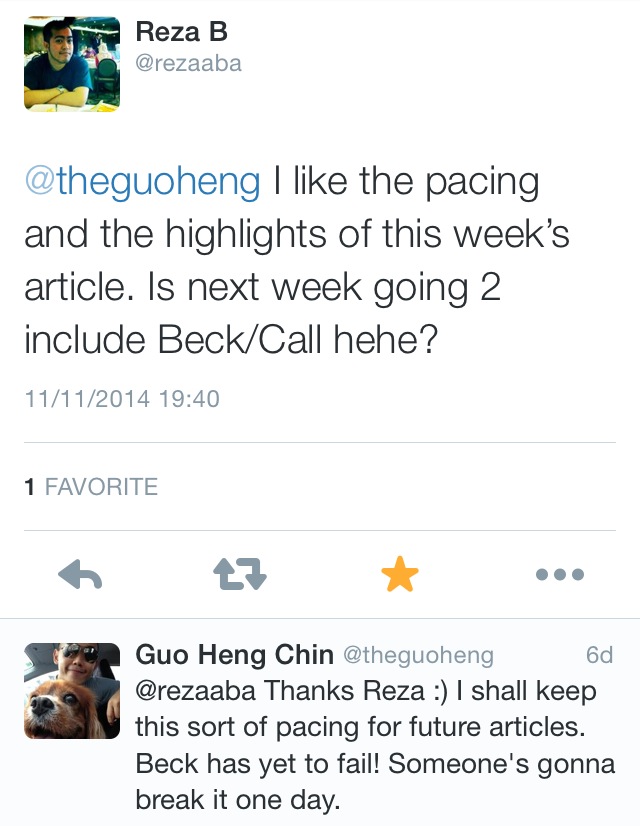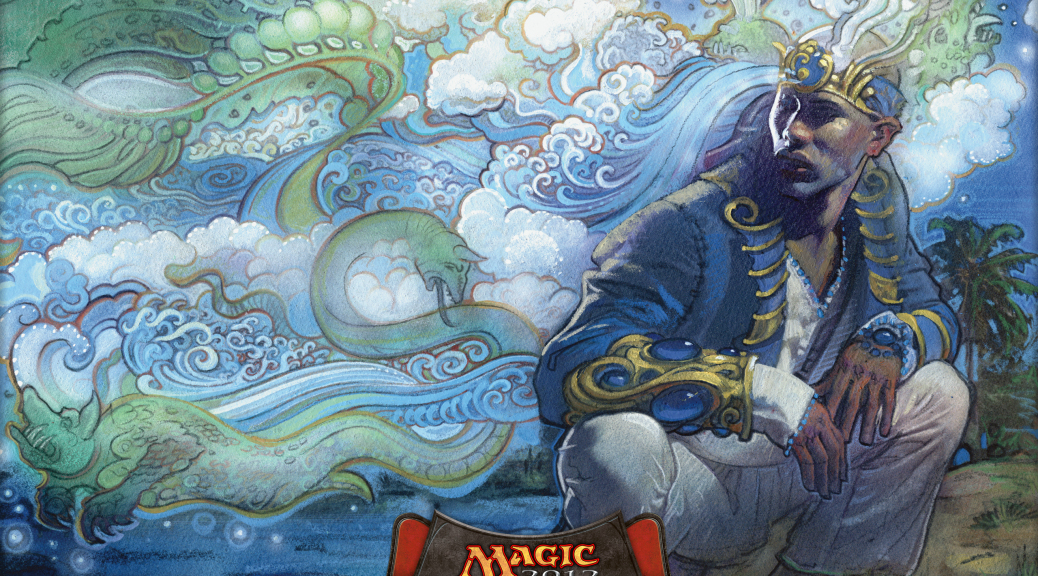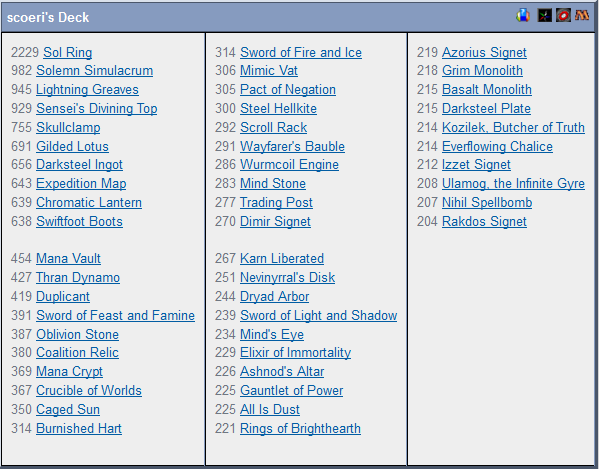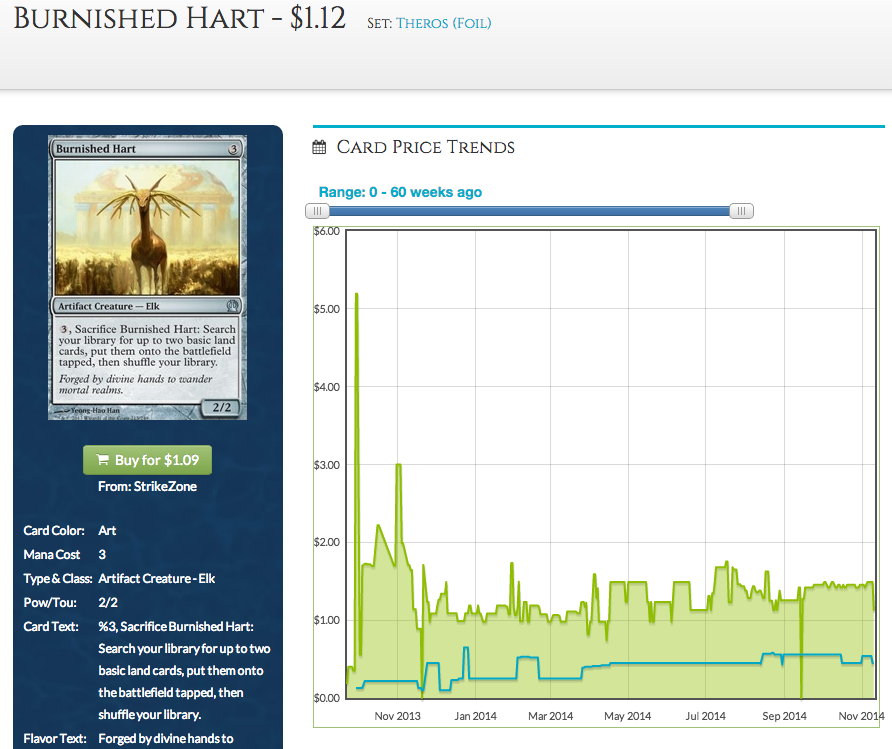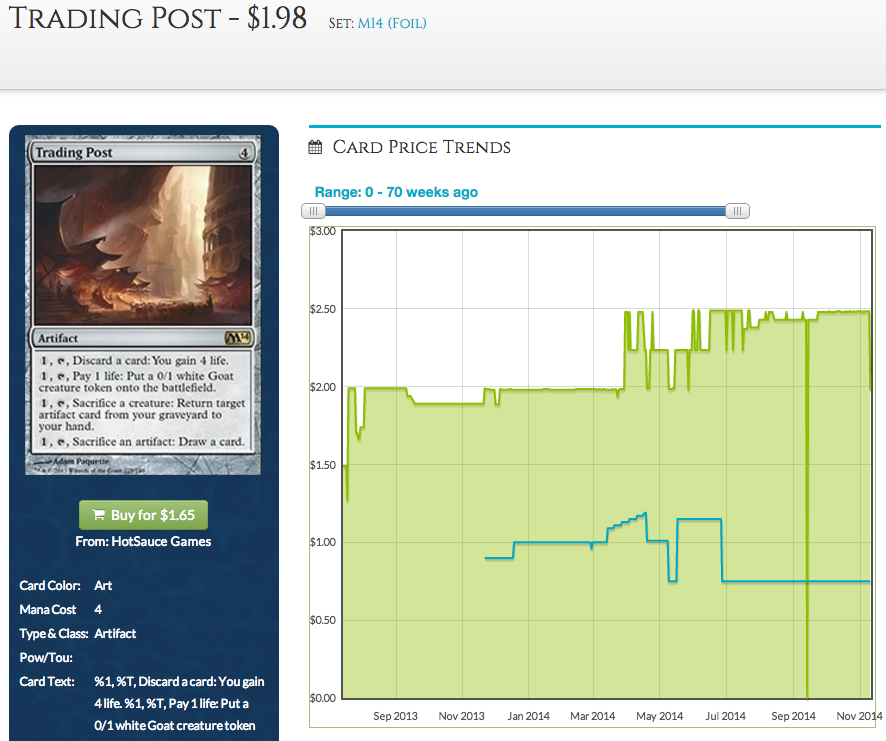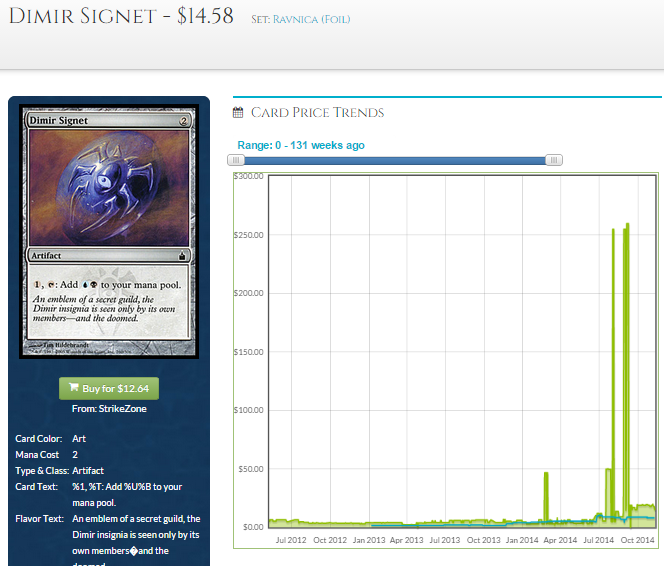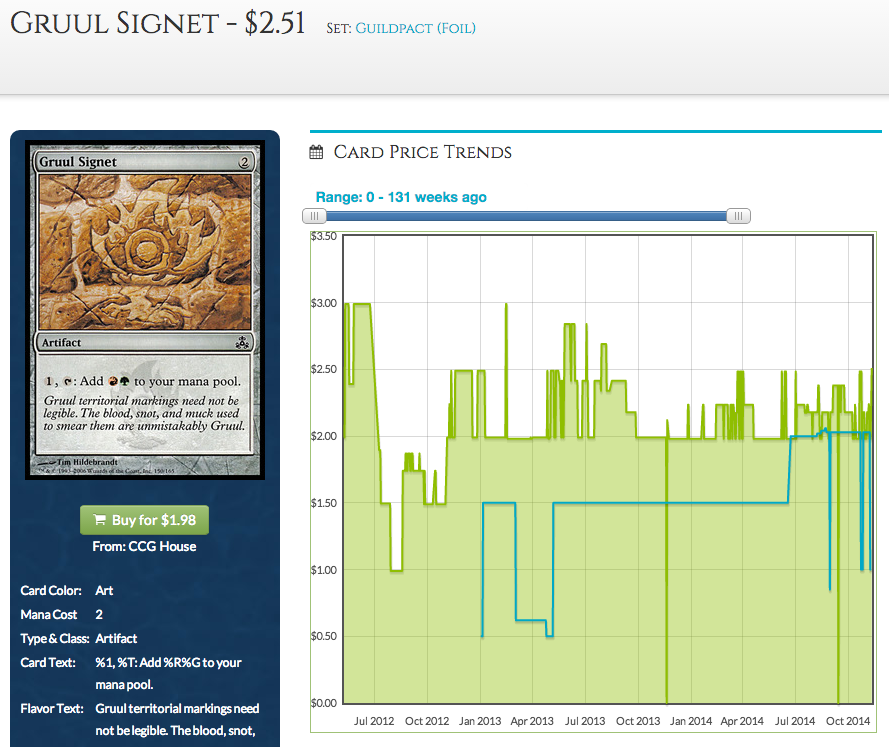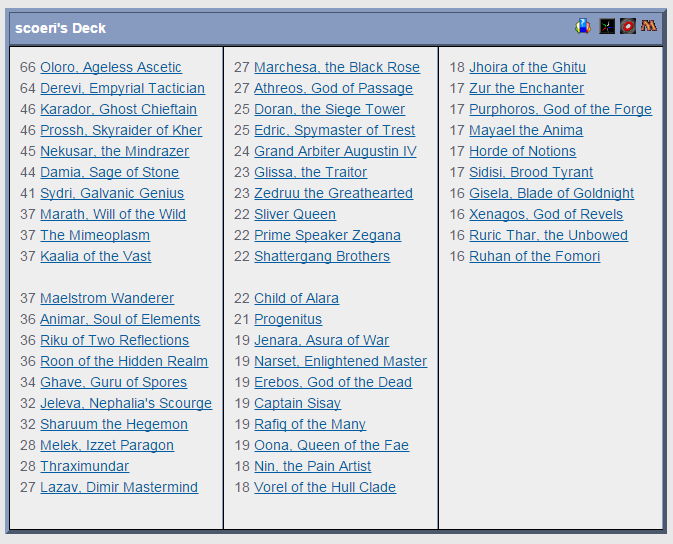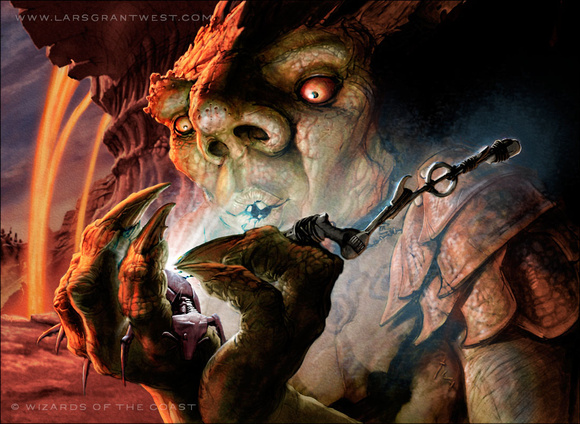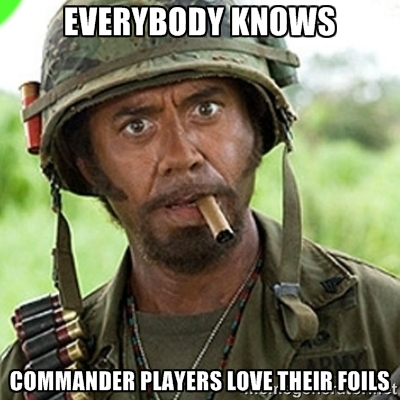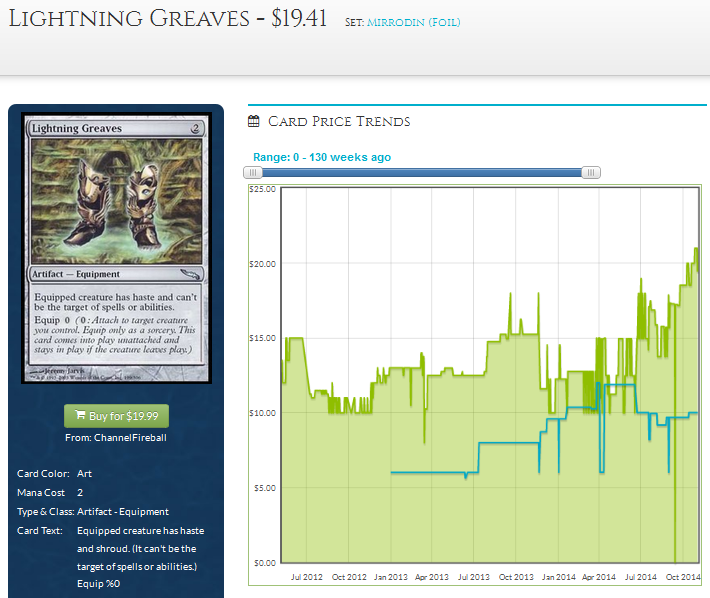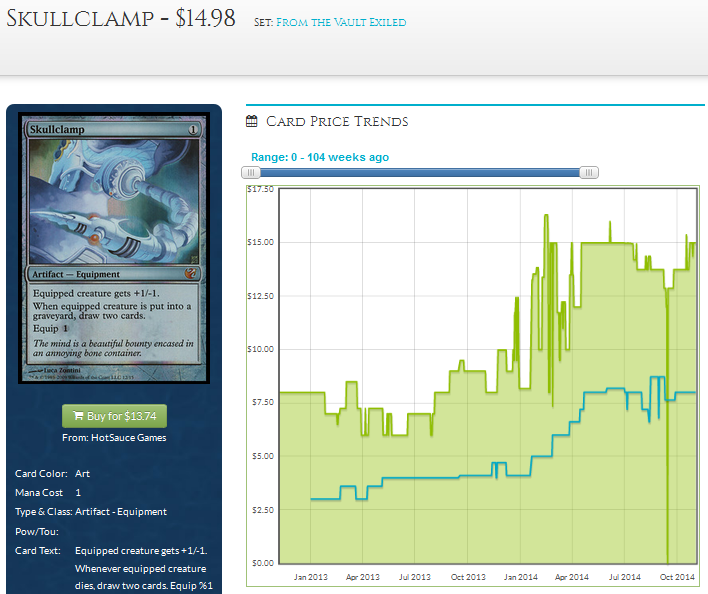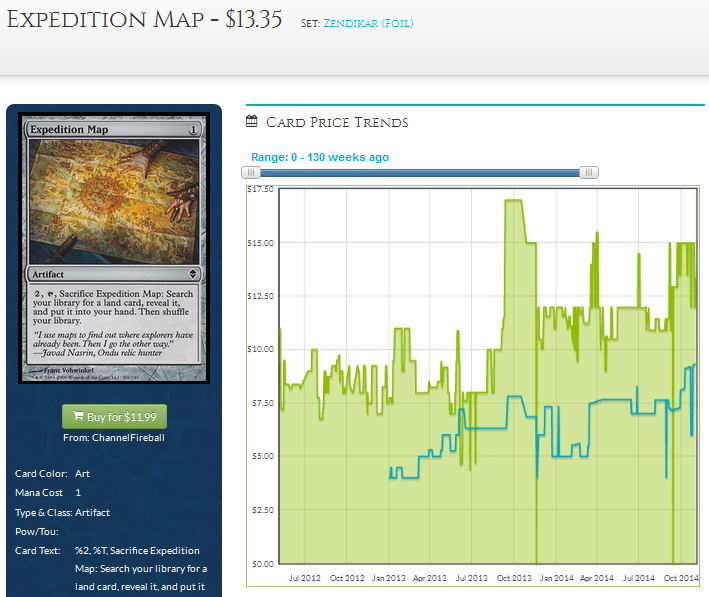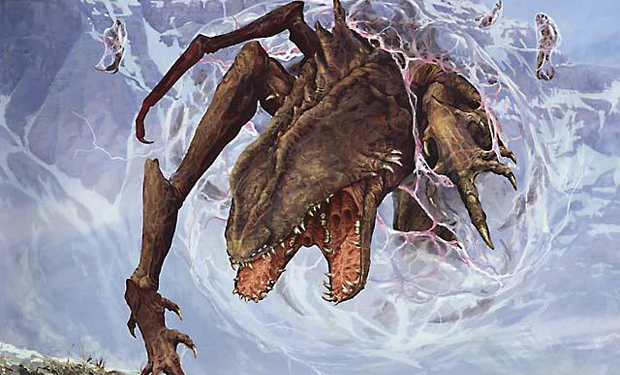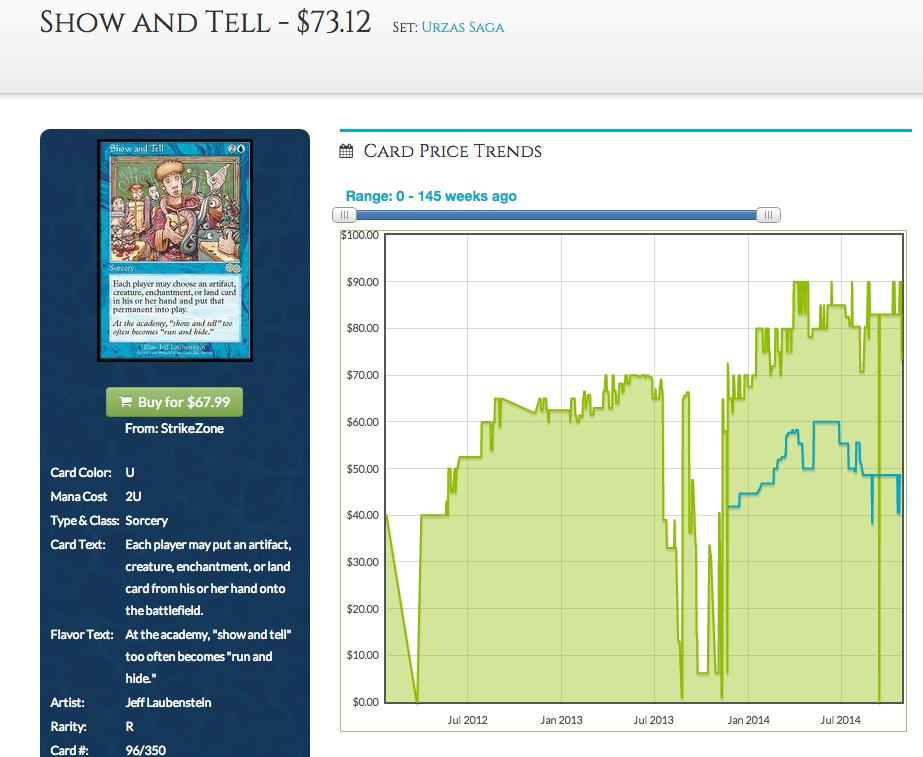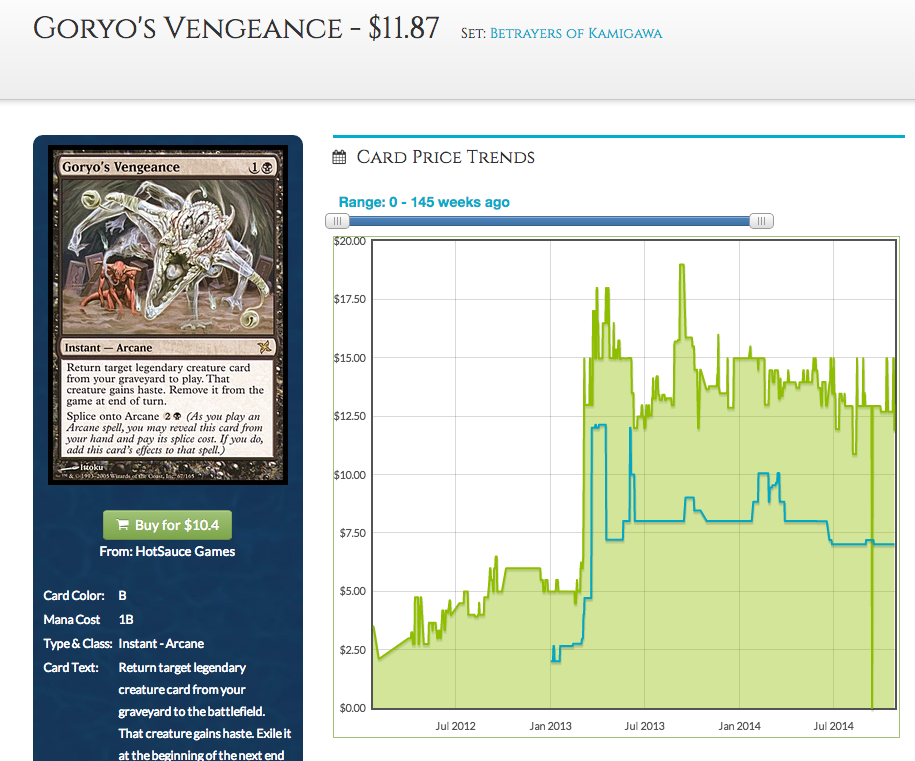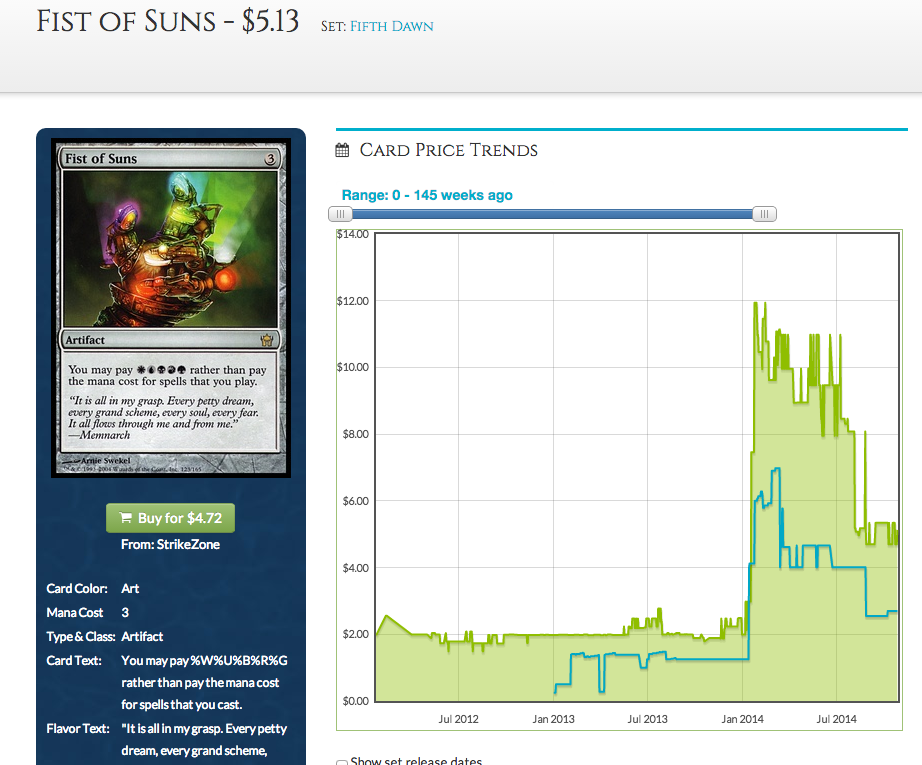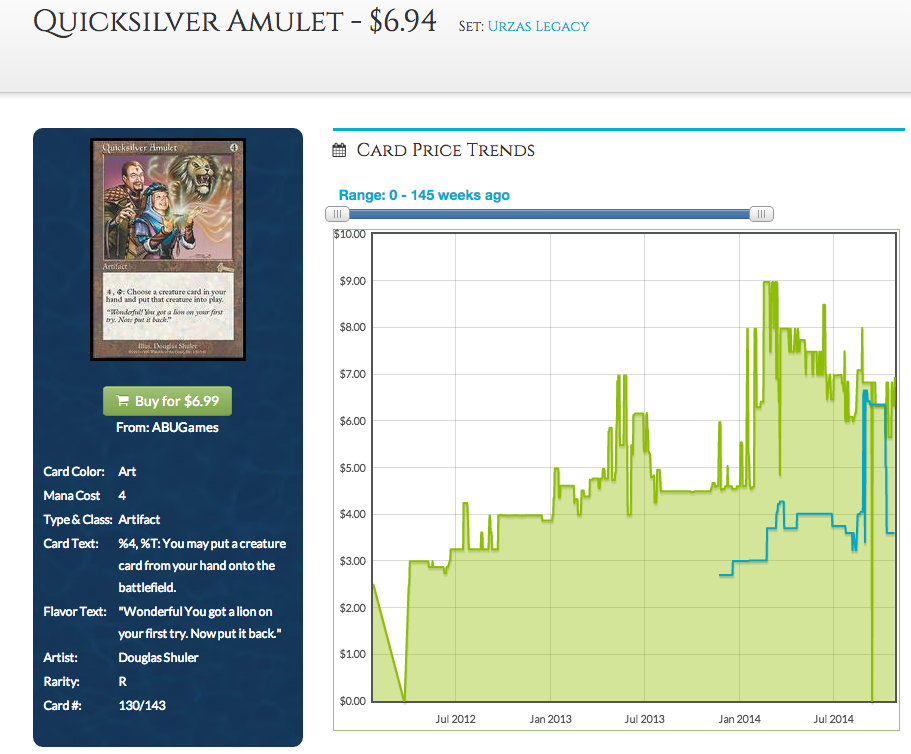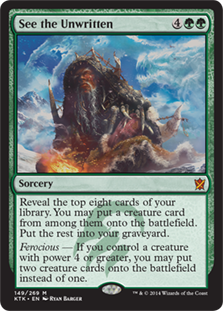By Guo Heng Chin
In Magic finance, you win some and you lose some, as with playing the game of Magic itself. Today, instead of foraging for undervalued cards, I am casting a retrospective glance over my three years of dabbling in Magic finance and dig through my speculation history for my hits and misses and the lessons I have learned from them.
Liquidity Matters
My first successful spec was Blazing Shoal during Pro Tour Philadelphia 2011, where Modern made its debut as a Pro Tour format. Blazing Shoal Infect was the breakout deck amid a field of turn three Storm decks; it was able to consistently win on turn two and was far more resilient than Storm. Blazing Shoal put Sam Black on the top 8 of that Pro Tour and if I recall correctly, he executed a turn two kill on camera, not something Wizards was particularly impressed with for a format they were trying to nurture.
I snagged a few playsets of Blazing Shoal online at near bulk before they ran out. I was ecstatic when they spiked 300% over the Pro Tour weekend. The cards arrived the week after and I started listing them on eBay.
It was my first time selling specs on eBay. I initially listed all of them under one listing with a set Buy It Now price. They did not sell well. I thought that due to the sheer number of available copies I listed, there were no urgency for viewers to buy them. So I took the listing down, and started listing my Burning Shoals as playsets with a seven-day auction. People prefer auctions don’t they? Then it dawned upon me that listing multiple playsets of the same card made me my own competitor and thinned out the list of potential bidders for each listing.
In the end I decided to list one playset per week. I did not get to my second playset when the banhammer fell upon Blazing Shoal.
Understanding your avenues for liquidity is as important as knowing when to move into a spec as it is the other half of the alchemic equation to transmute your specs into cash. It is imperative to ensure that the the quantity of your specs correspond to your ability to move them.
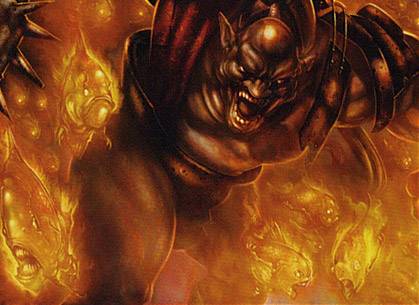
Back then in London, there were not many local shops to buylist my cards and I was not aware of peer-to-peer outlets like MagicCardMarket.eu. The idea of sending my cards to major retailers in the United States did not occurred to me as well, the Magic finance noob I was back then. So I defaulted to eBay, which was probably not the wisest choice to move a large amount of cards fast.
What Jace Thought Me
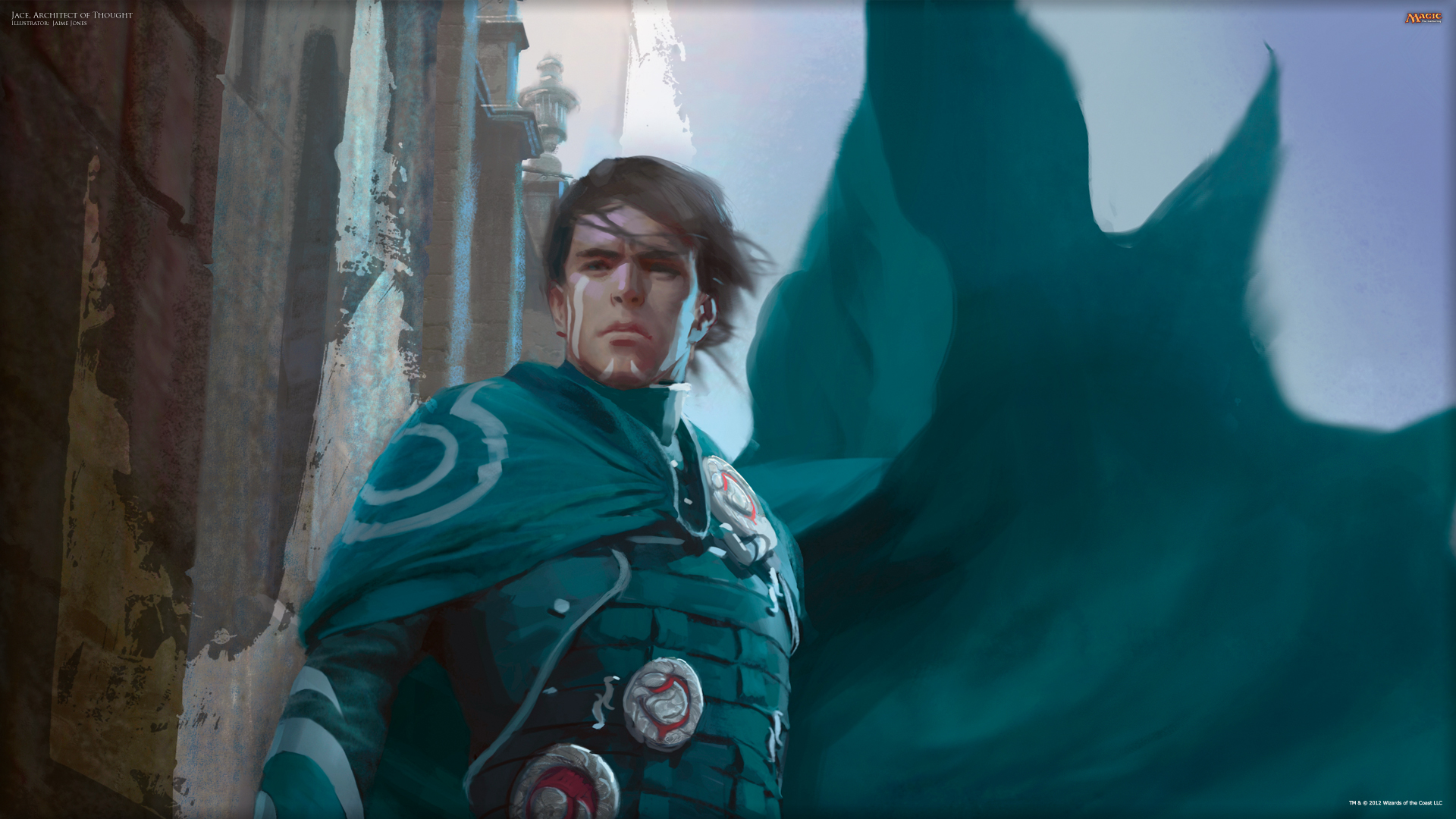
Jace, Architect of Thought holds a sweet spot in my memory of Magic specs. Up till today, he was the only spec that made me money not once, but twice.
The first time Jace made me cash was down to some not insignificant amount of luck. I recall discussing Jace in my local Magic Facebook group when he was first spoiled. I was pretty bullish on him, my argument being that he is a mini Fact or Fiction on a stick and he protects himself. Others were not so enthusiastic, some even relegated him to the financial wasteland of being only playable in Commander (that was back before Commander were a driving force of card price). After all, his plus one ability gets better with more opponents, no?
I kept Jace on my eBay watchlist for a few days before pulling the trigger on a presale playset at $25 each, afraid that if I waited any longer, he will be start to spike, as with most presale cards. But four days later, Jace, who is now an architect rather than a sculptor, not only not see an increase in presale price, but is now available at $21.99. I bought another playset.
Less than a month later, when Return to Ravnica was barely legal for a week, Todd Anderson took down an StarCityGames Standard Open with UWR Miracles running a full four copies of Jace, Architect of Thought. The deck was a one-shot pony, but I am sure most of you recall the resulting spike where Jace shot up to $50 for a brief period of time. The nature of Magic price spikes is that it happens fast, but it takes a while to tank. It was not until mid-December before Jace fell below twenty. I cashed out my extra playset of Architect of Thought for $40 apiece, covering most of the cost of my own playset.
That was mostly luck; buying in at $25 hoping to make a profit will only work if the card spikes to $40 – 50, and I suspect Jace was only able to do that on the virtue of being a new card on top of being played as a four-of in the winning deck of the first major Standard tournament after the set rotated in. The more financially savvy me in 2014 would not advocate buying a presale Planeswalker at $25 as a spec (though Sarkhan, the Dragonspeaker is wagging his dragon tail at my face for not investing in a few of him at presale price. A point of consideration: it might be worth acquiring marquee Planeswalkers at presale price for your own personal use. You would have saved quite a lot buying your personal playset of Elspeth, Sun’s Champion and Sarkhan, the Dragonspeaker at their presale prices).
While the first time Jace made me some bucks could be attributed to a decent amount of luck, the second time Jace turned me a hefty profit was not.
About a month into Return to Ravnica Standard, a Japanese tech surfaced: UWR tempo running Thundermaw Hellkite alongside Geist of Saint Traft and Restoration Angel. Thundermaw Hellkite worked marvelously in tandem with Geist of Saint Traft: nine unstoppable damage in the air out of nowhere. Geist on turn three, Restoration Angel on turn four and Thundermaw for the lethal alpha strike on turn five happened quite a lot.
Shortly after that, in mid-November 2012, Jon Bolding and Tyler Lytle took down two Standard Grand Prix one week after another, both running BR Big Zombies featuring three Thundermaw Hellkites. The dragon has awaken.
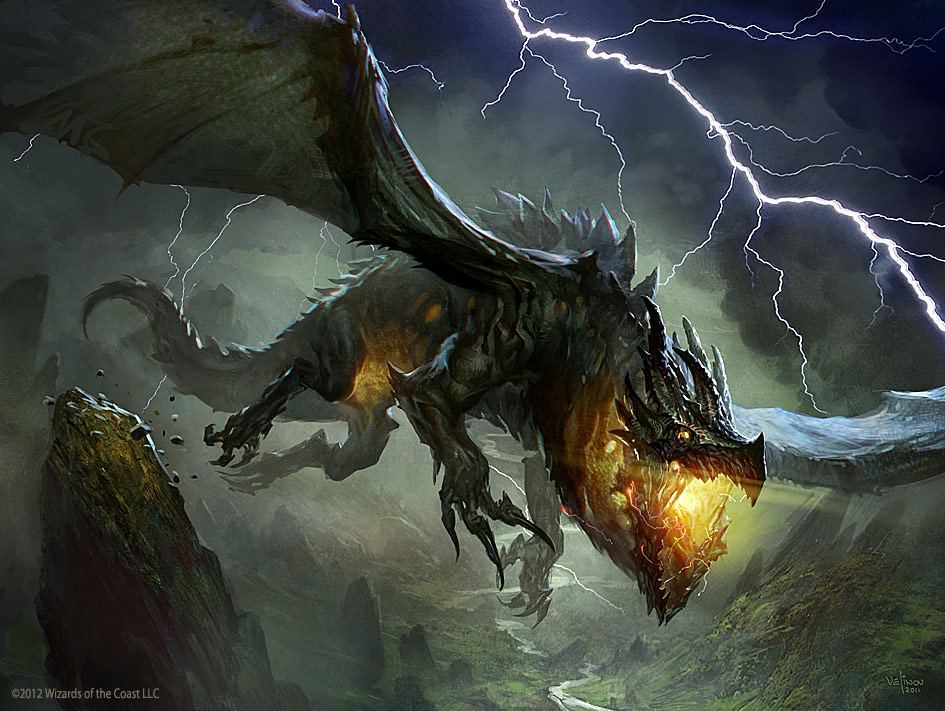
Jace did not do well in a meta where Thundermaw Hellkite was the king of the skies. It got worse when Tom Martell took down Pro Tour Gatecrash with The Aristocrats and the deck became a tier one mainstay for the rest of Return to Ravnica Standard. Turn four Jace, Architect of Thought was not impressive when your opponent followed up with a Falkenrath Aristocrat and/or Thundermaw Hellkite.
So Jace’s price tanked and tanked further. By April 2013, Jace hit rock bottom at $10. During the following months, I bought and traded for Jaces at $10 – $12 apiece. He was too good to warrant a price tag that low. Furthermore, Jace was the most played card in the top 8 of the Block Constructed Pro Tour Dragon’s Maze. That is some convincing data.
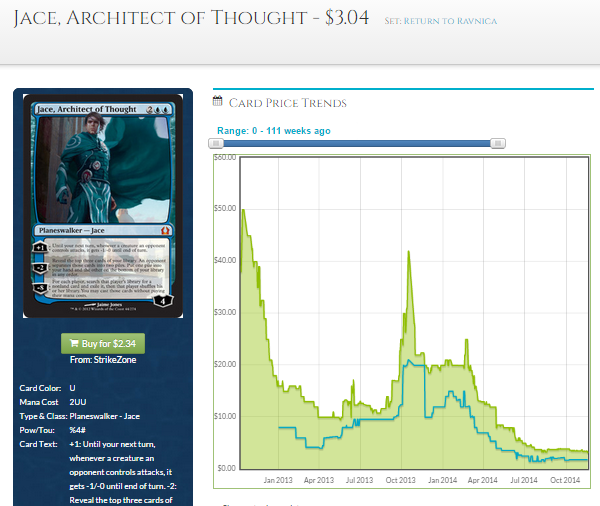
True enough, in October 2013 when the Hellkites and Aristocrats rotated out and Theros rotated in, Jace spiked. UW Control with four Jaces piloted by Max Tietze took second place at the first major Standard tournament. Pro Tour Theros that followed saw 16 Jaces in the top 8 decks.
Jace significantly subsidised my entry into Theros Standard. Trading Jaces for Stormbreath Dragons and Elspeth, Sun’s Champions allowed me to play most tier one decks during a period when I was unemployed.
The biggest take home message I got from my affair with Jace was to trust my own analysis of a card, even though it goes against the market sentiment, as long as my conclusions are derived from solid reasoning (as opposed to a hunch) and preferably, data. I know, it sounds like a protip, but it is not easy to pull the trigger on a card you know has potential to be worth more than it currently is when the market thinks otherwise.
My reasoning for Jace, Architect of Thought were as follows: He is competitively costed and protects himself. Sounds good. He is a versatile card with abilities you would like to have in both aggro and midrange/control matchups and are useful to catch up or to seal the deal when you are ahead. That makes Jace a candidate for multiple copies in decks that run him. I am getting convinced.
He is a mini Fact or Fiction on a stick.
Sometimes the market undervalues a card because the metagame is unfavorable to the card. Thundermaw Hellkite pushed the boundary for the acceptable power level of creatures (back in my days, you had to sacrifice two mountains for an undercosted dragon and you don’t even get Haste) but yet dropped to $10 in the first six months of its Standard legal life. No one wanted to tap five for a creature in a field of Vapor Snag and Snapcaster Mage for more Vapor Snag. Once Vapor Snag rotated out, it was only a matter of time before someone figured out that jamming multiple Thundermaw Hellkites in a deck was the way to go.
Another factor to keep in mind is that it takes a while for the Magic community to appreciate the power of new cards. Courser of Kruphix started out as a $5 rare even though it is a value engine in a single card at three casting cost. It took a month for Courser to hit $10 and three to hit $20.
I was a little late to the party, having bought my Coursers at $7. My arguments were that Courser has three useful abilities and is in a set that is not going to be opened a lot. Courser also had potential in Modern with its four toughness and synergy with fetchlands, Tarmogoyf and Dark Confidant. So while people were still trying out Courser in both Standard and Modern, I was busy buying Coursers.
Eidolon of the Great Revel went through the same journey into profitabilty. It has a fairly unique ability, which made it hard to evaluate. I totally misunderstood the ability the first time I read it, before I realised the card has the potential to be absolutely devastating in Modern and Legacy where most cards cost three or less mana. But Eidolon of the Great Revel was not seeing any play at all. At least in the first few months of its existence.
The turning point for me to buy in was hearing Zac Hill discuss Eidolon of the Great Revel in a Brainstorm Brewery set review episode where he mentioned something along the lines of Eidolon of the Great Revel having a unique design and he has no idea how to price it. At that time, Eidolon was around $2. That is certainly not the price for as cross-format playable card with a unique design. I bought a few playsets at $2 and threw into the card three foil copies at $7 each.
In retrospect I should have bought a playset of foils instead of just three. Foils of Modern and Legacy staples are worth a lot I hear.
Wide Applications
Sometimes even though my analysis and playtesting showed that a card is more powerful than its market price indicted, there are still factors that could limit the growth of the card. Duskmantle Seer proved to be a beast during playtesting using the Sultai shell which briefly made waves when it was featured on the mothership after taking down a Brazilian WMCQ. Duskmantle Seer’s symmetrical effect was mitigated by the fact that you get to use the extra card first, and you could design your deck to have a lower curve to reduce the damage you take. His 4/4 flying body and ability to force your opponent to take damage off his Dark Confidant clause provided a good clock.
But Duskmantle Seer did not take off.

In retrospect, it seemed obvious why Duskmantle Seer had a narrow chance of spiking. His blue and black mana requirement greatly reduced the range of decks that could run him. I do not think that being multicolored made it a bad spec; Sphinx’s Revelation had an explosive growth. I think the death knell for Duskmantle was the fact that he was only optimal in decks designed to mitigate his Dark Confidant clause, thus further limiting the range of decks that runs him.
After all, a card’s price is a function of its playability.
Future Sight
While it’s painful to get burned on a spec, they provide valuable data we could use to fine tune our approach to reduce our failure rate in future specs. Of course, no one could predict for certain what card will spike next. The best we could do is position ourselves to have the best chance of striking it, very much like playing competitive Magic.
And maybe hope a little.
